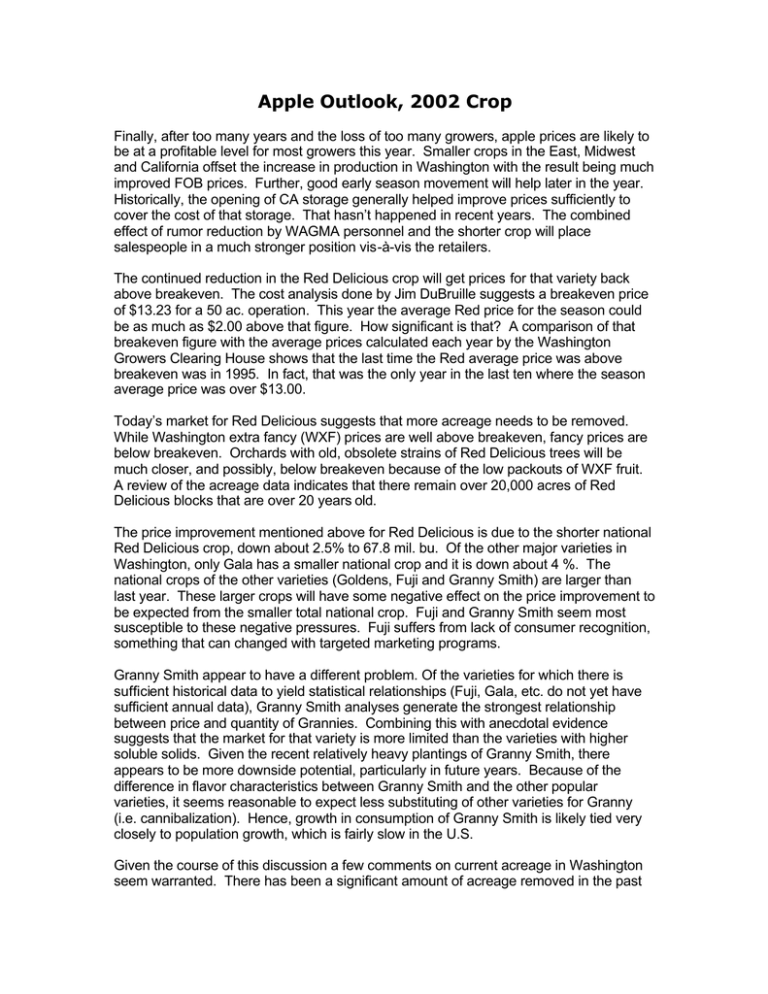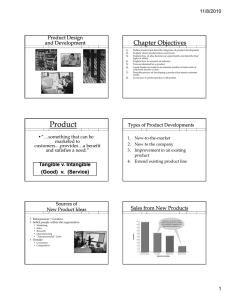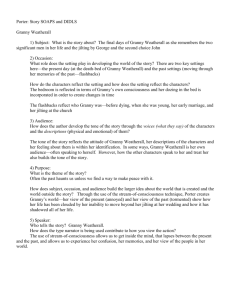Apple Outlook, 2002 Crop
advertisement

Apple Outlook, 2002 Crop Finally, after too many years and the loss of too many growers, apple prices are likely to be at a profitable level for most growers this year. Smaller crops in the East, Midwest and California offset the increase in production in Washington with the result being much improved FOB prices. Further, good early season movement will help later in the year. Historically, the opening of CA storage generally helped improve prices sufficiently to cover the cost of that storage. That hasn’t happened in recent years. The combined effect of rumor reduction by WAGMA personnel and the shorter crop will place salespeople in a much stronger position vis-à-vis the retailers. The continued reduction in the Red Delicious crop will get prices for that variety back above breakeven. The cost analysis done by Jim DuBruille suggests a breakeven price of $13.23 for a 50 ac. operation. This year the average Red price for the season could be as much as $2.00 above that figure. How significant is that? A comparison of that breakeven figure with the average prices calculated each year by the Washington Growers Clearing House shows that the last time the Red average price was above breakeven was in 1995. In fact, that was the only year in the last ten where the season average price was over $13.00. Today’s market for Red Delicious suggests that more acreage needs to be removed. While Washington extra fancy (WXF) prices are well above breakeven, fancy prices are below breakeven. Orchards with old, obsolete strains of Red Delicious trees will be much closer, and possibly, below breakeven because of the low packouts of WXF fruit. A review of the acreage data indicates that there remain over 20,000 acres of Red Delicious blocks that are over 20 years old. The price improvement mentioned above for Red Delicious is due to the shorter national Red Delicious crop, down about 2.5% to 67.8 mil. bu. Of the other major varieties in Washington, only Gala has a smaller national crop and it is down about 4 %. The national crops of the other varieties (Goldens, Fuji and Granny Smith) are larger than last year. These larger crops will have some negative effect on the price improvement to be expected from the smaller total national crop. Fuji and Granny Smith seem most susceptible to these negative pressures. Fuji suffers from lack of consumer recognition, something that can changed with targeted marketing programs. Granny Smith appear to have a different problem. Of the varieties for which there is sufficient historical data to yield statistical relationships (Fuji, Gala, etc. do not yet have sufficient annual data), Granny Smith analyses generate the strongest relationship between price and quantity of Grannies. Combining this with anecdotal evidence suggests that the market for that variety is more limited than the varieties with higher soluble solids. Given the recent relatively heavy plantings of Granny Smith, there appears to be more downside potential, particularly in future years. Because of the difference in flavor characteristics between Granny Smith and the other popular varieties, it seems reasonable to expect less substituting of other varieties for Granny (i.e. cannibalization). Hence, growth in consumption of Granny Smith is likely tied very closely to population growth, which is fairly slow in the U.S. Given the course of this discussion a few comments on current acreage in Washington seem warranted. There has been a significant amount of acreage removed in the past two years. Fortunately, the Yakima Valley Growers-Shippers Association and the Wenatchee Valley Traffic Association have conducted two surveys of member shippers since the last fruit tree survey by the Washington Agricultural Statistics Service. The association surveys requested information on acreage removed by variety. Table 1 below combines the information from all three sources to get the current estimate by variety. Since the first association survey overlapped with the WASS survey, it was assumed that half of the acreage reported by the associations as having been removed was reflected in the WASS numbers. The resulting numbers indicate that almost 24,000 acres have been removed since January 1, 2002. Looking back a bit further to the 1997 Census of Agriculture, 204,765 acres of apples were reported. Thus, in the past five years, about 37,000 acres have been removed. These numbers do not, however, include the trees that have been planted since the fruit tree survey. While the actual number of trees sold is not yet available, it has been estimated that several million were sold. Allowing for privately produced trees, we estimate that there are about 175,000 acres of apples in Washington currently. While market conditions will help growers this year, the industry is not out of the woods yet. Next year the other growing areas will likely be back with much larger volumes. The result will be significantly lower prices. Because consumers don’t change consumption patterns very quickly, the quantity available is the most important factor affecting prices. Reds Goldens Granny Fuji Gala Other Total Table 1. Acreage In Washington 2001 Fruit Current Survey* Estimate 82,000 66,709 27,000 25,324 17,600 16,669 24,400 22,537 25,500 23,775 15,500 13,227 192,000 168,241 * Washington Agricultural Statistics Service




